
Mastering HubSpot CRM is more than just learning a new tool—it’s about reshaping the way you connect with your customers.
In this article, we’ll discuss the basics of how to use HubSpot CRM, including a clear and concise walkthrough of its dynamic features. We’ll also cover tips on truly leveraging it to its fullest potential.
Step 1: Set Up Your Account
Just as it is with learning how to use on-demand services in general, it’s best to start with an account so you can explore the platform’s user interface and features.
Create an account at HubSpot’s website. Click “Get started free.” You can sign up without having to use a credit card.
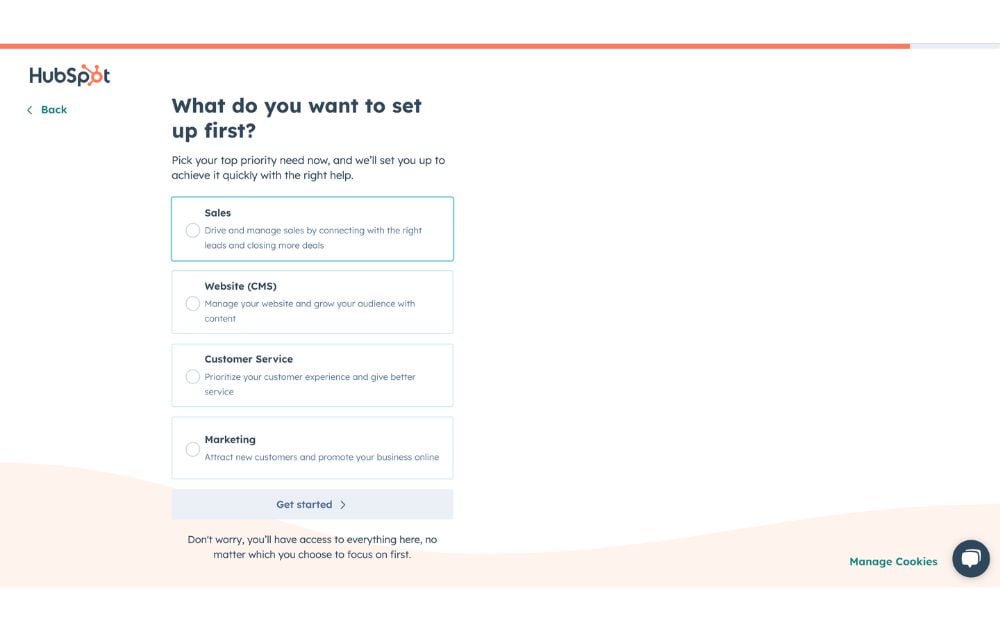
Setting up your account involves more than just entering basic information. It’s about tailoring the CRM environment to align with your business’s unique needs and objectives. This includes:
- Choosing the appropriate subscription plan
- Customizing user permissions
- Integrating existing tools
- Configuring initial settings for your operations
During this setup phase, you can invite team members, ensuring the right individuals can access the tools and data they need.
Step 2: Manage Your CRM Database
You must manage your CRM (Customer Relationship Management) database effectively to maintain organized and efficient communication with your customers. If you’re just learning how to use HubSpot CRM, you must learn the basics of importing, categorizing, and segmenting data.
- Importing Data. At your HubSpot dashboard, click on the “Contacts” tab and select “Import.” You’ll then have two options – the first is to import contact, company, deal, ticket, or product information into HubSpot. The second option is to sync data between HubSpot and other apps.
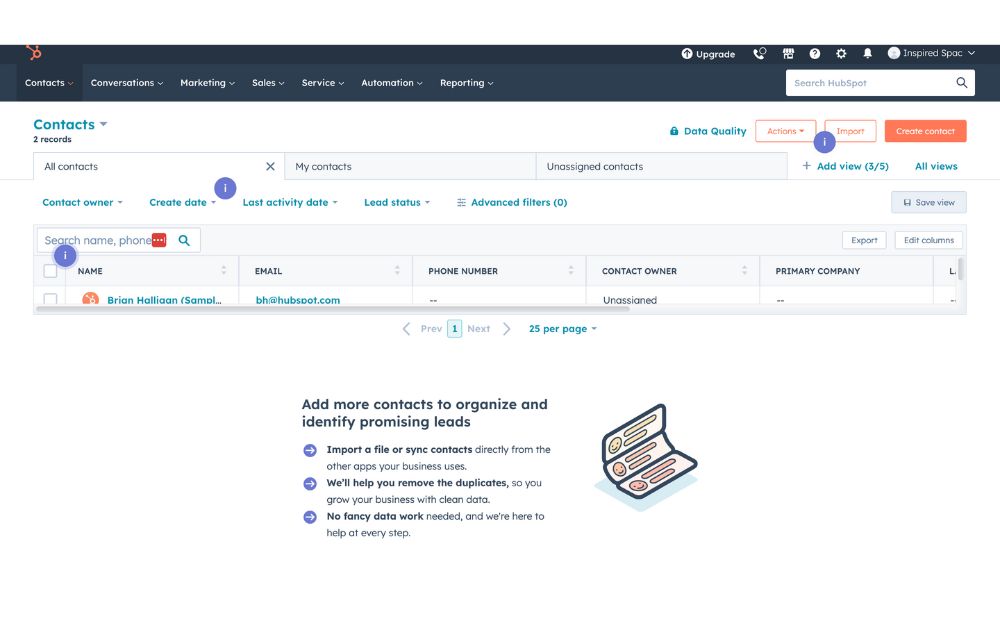
TIP: Always back up your data before importing. Ensure that the data is clean, with no duplicates or errors, to prevent any issues during the import process.
- Categorizing Data. In HubSpot, Properties are like fields in a database. They help categorize and store specific information about your contacts, companies, deals, and more. Setting up properties correctly ensures that you can segment and analyze your data effectively. Go to “Settings” by clicking the gear icon at the upper right portion of the screen. Under “Data Management,” select “Properties.” Click on “Create property” to add a new property. Define the property’s name, type, and associated groups before saving.
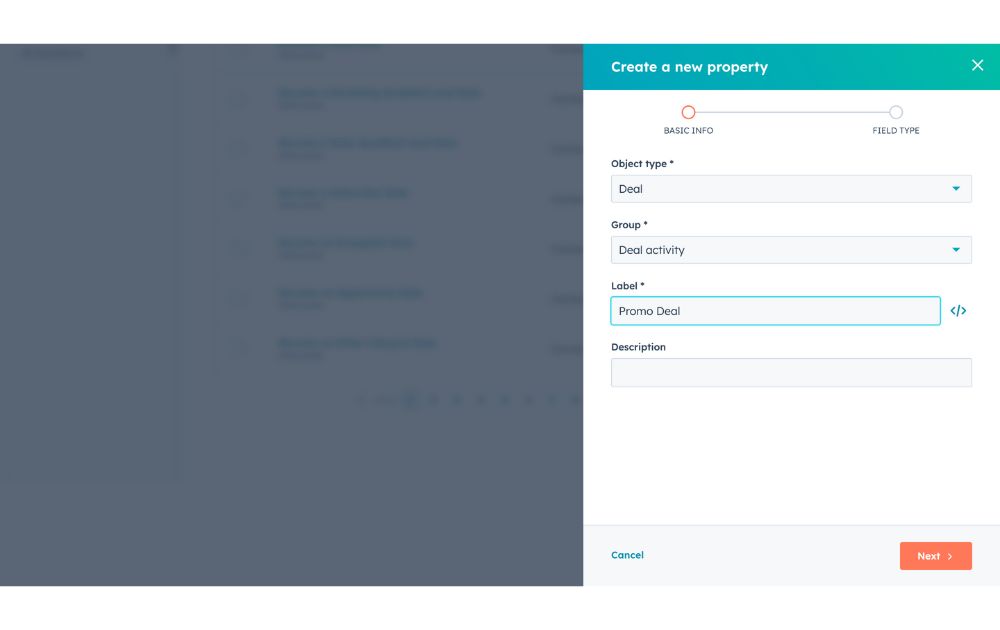
TIP: Regularly review and update your properties to ensure they align with your current business needs. Avoid creating too many properties that might not be used, as it can clutter your CRM.
- Segmenting Data. Segmenting your CRM data allows you to group contacts based on specific criteria, such as their location, purchase history, or behavior on your website. Click the “Contacts” tab and select “Lists” from the dropdown menu. Click “Create List” and click on the type of list you want to create – contact-based, company-based, or deal-based.
TIP: Test different segmentation strategies to identify which ones yield the best results for your campaigns.
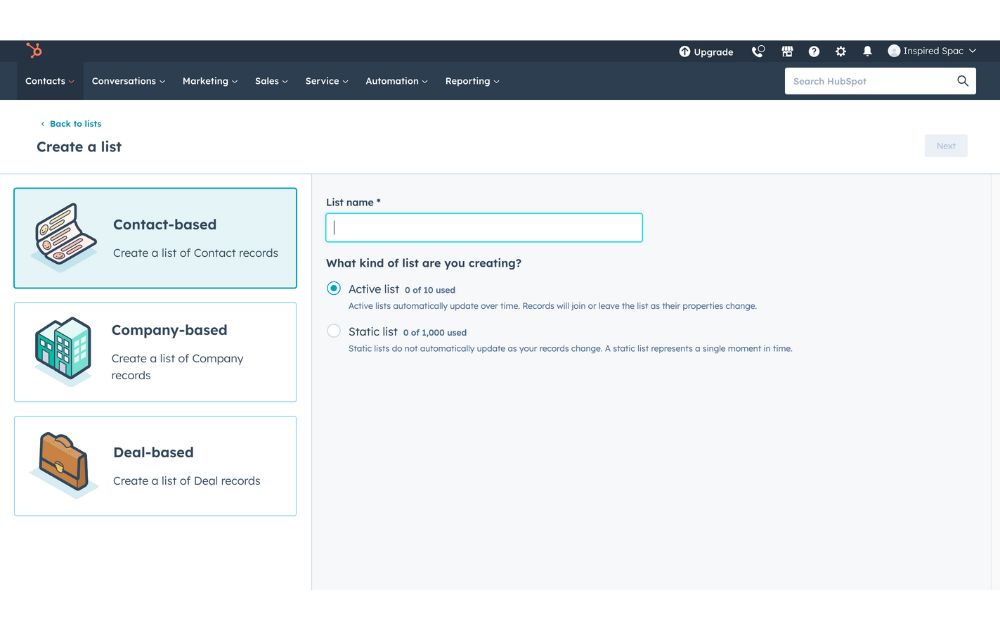
Step 3: Market Your Business
Many people want to learn how to use HubSpot CRM to be able to use it to enhance their marketing efforts. Here’s how to use CRM for marketing by reaching the right audience, engaging them, and converting them into loyal customers.
- Create Landing Pages to Capture Leads. In the “Marketing” tab in your HubSpot dashboard, select “Landing Pages.” Click on “Create” and then “Landing page” to start using HubSpot’s drag-and-drop builder. Here, you can customize the content, design, and call-to-action to align with your campaign goals. Publish the page once you’re satisfied with its look and functionality.
TIP: Ensure your landing page has a clear and compelling call to action. Do A/B tests with different versions to determine which one resonates best with your audience.
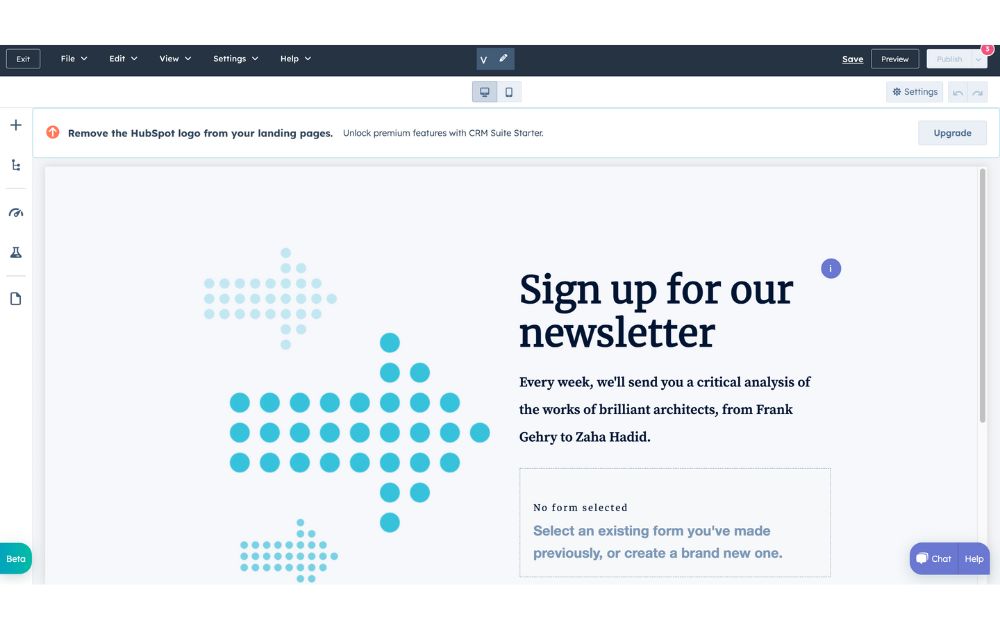
- Design and Send Out Emails to Contacts. Email marketing remains one of the most effective ways to engage with your audience, promote products, and nurture leads. In the “Marketing” tab, select “Email.” Click on “Create email” and choose whether you want a regular, automated, or blog email type. You can then select a template and customize your email content, subject line, and recipient list. Schedule or send the email immediately.
TIP: Segment your email list to send targeted messages. Monitor open rates and click-through rates to gauge the effectiveness of your emails.
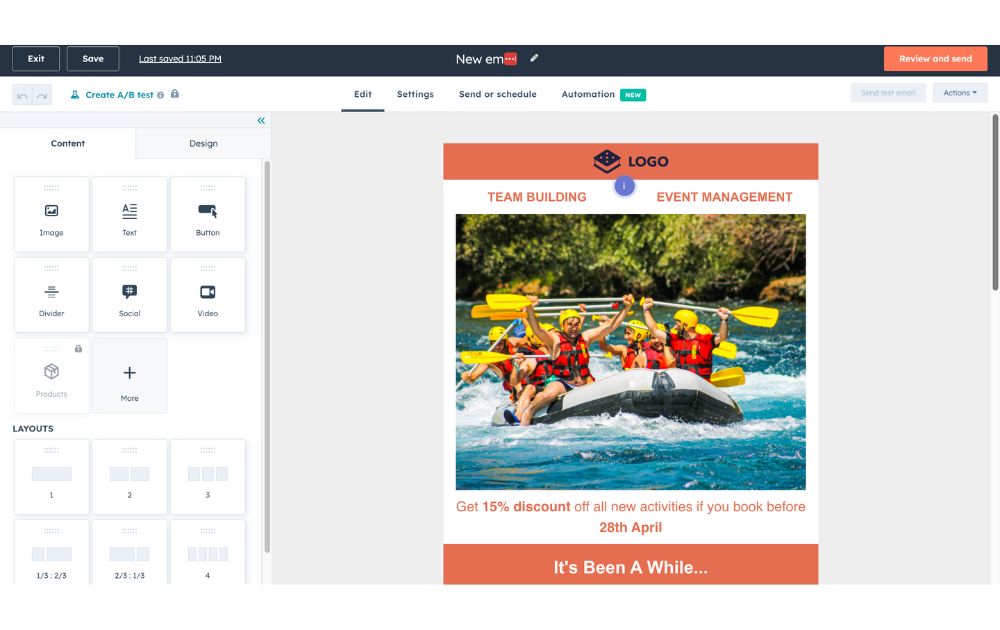
- Set Up Ad Campaigns to Attract Potential Customers. Ad campaigns can significantly enhance your brand’s visibility. That said, it’s crucial to learn how to use HubSpot CRM for marketing to boost your campaigns. In the “Marketing” tab, select “Ads.” Connect your ad accounts (e.g., Google Ads, Facebook Ads) and create and manage your ad campaigns directly from HubSpot.
TIP: Track the performance and ROI of each campaign. Set clear goals and budgets for each campaign.
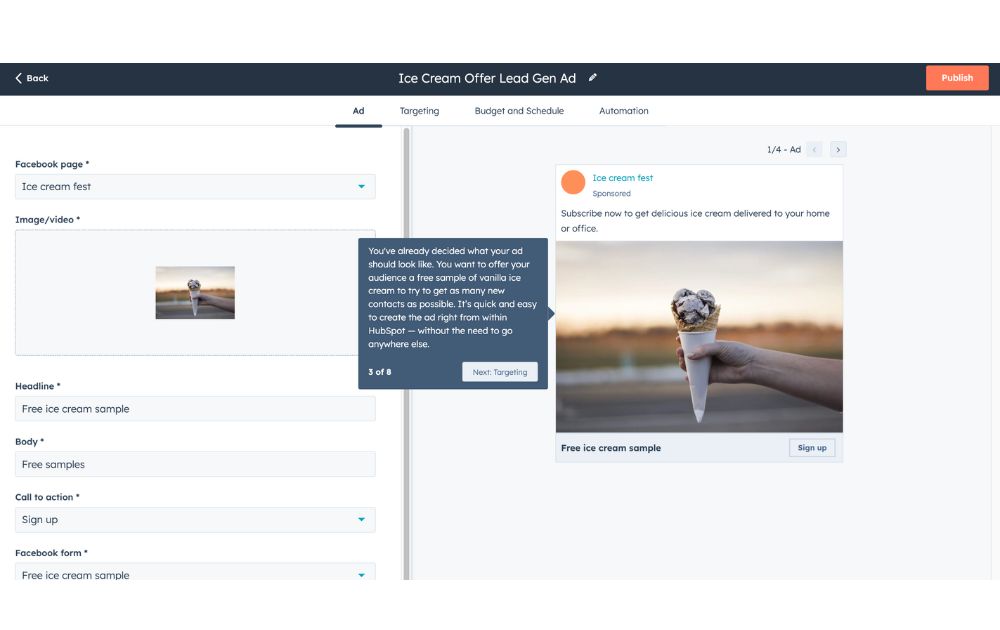
Step 4: Generate Sales
You can enjoy ROI on subscription costs if you how to use HubSpot CRM to facilitate every stage of the sales funnel. Here’s how to do it:
- Engage with Leads through the CRM. Engaging with leads effectively can set the tone for the entire sales process. In the “Contacts” section, view the list of leads and their respective engagement histories. Use the built-in chat tools or email integrations to initiate conversations. You can also set reminders and follow-up tasks to ensure consistent engagement.
TIP: Personalize your interactions based on the lead’s behavior and history. Utilize HubSpot’s insights to tailor your approach, ensuring relevance and resonance.
- Close Deals and Track Them in the CRM. Tracking deals ensures transparency, accountability, and effective management of the sales pipeline. Go to the “Sales” tab and select “Deals.” Create a new deal or update an existing one with relevant details such as deal stage, value, and expected close date. Move deals through the sales pipeline stages as they progress. Attach relevant documents, notes, and communication logs to each deal for comprehensive tracking.
TIP: Regularly review and update deal stages to reflect their current status. Use the forecasting tools in HubSpot to predict revenue and manage resources effectively.
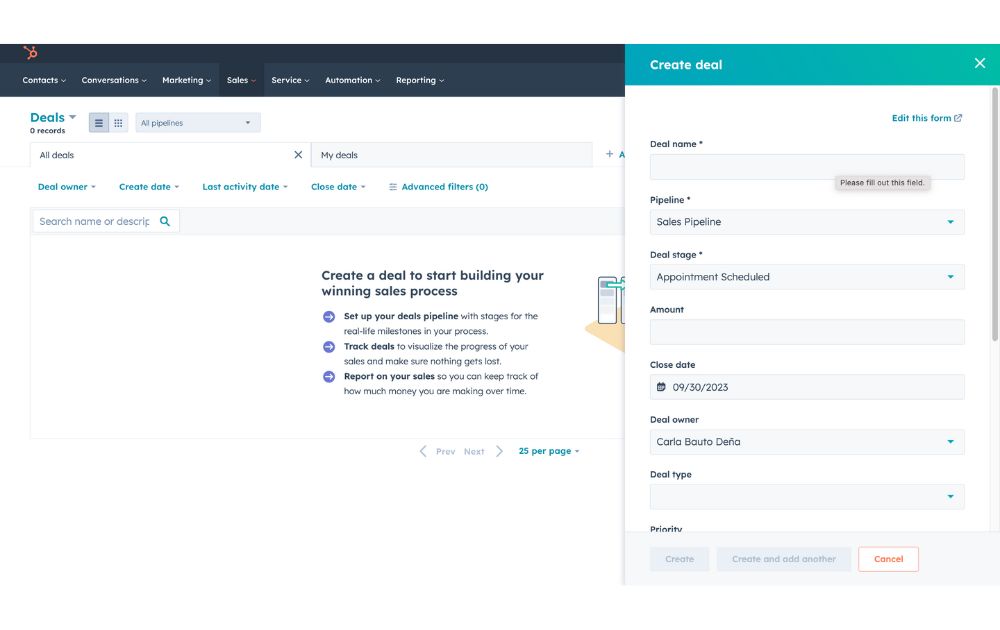
- Report on Your Sales Efforts. Reporting provides a clear overview of the sales team’s performance, highlighting successes and pinpointing areas that require attention. Go to the “Reporting” section in the dashboard, then click “Reports.” Access pre-built sales reports or create custom reports based on specific metrics.
TIP: Use the insights from the reports to refine your sales strategies. Identify patterns and trends to inform future sales initiatives and training programs.
Step 5: Support Your Customers
Customer support is not just about addressing issues; it’s about building trust, fostering loyalty, and ensuring that customers have a seamless experience with your brand. Here’s how to use HubSpot CRM to be closer to your customers:
- Manage Support Tickets. Support tickets are a structured way to track, manage, and resolve customer inquiries or issues. Navigate to the “Service” tab in your HubSpot dashboard. Click on “Tickets” to view, create, or manage support tickets. Use the integrated communication tools to interact with customers and update them on the resolution process.
TIP: Categorize tickets based on their nature (e.g., technical, billing) to streamline the resolution process. Ensure timely responses to maintain customer satisfaction.
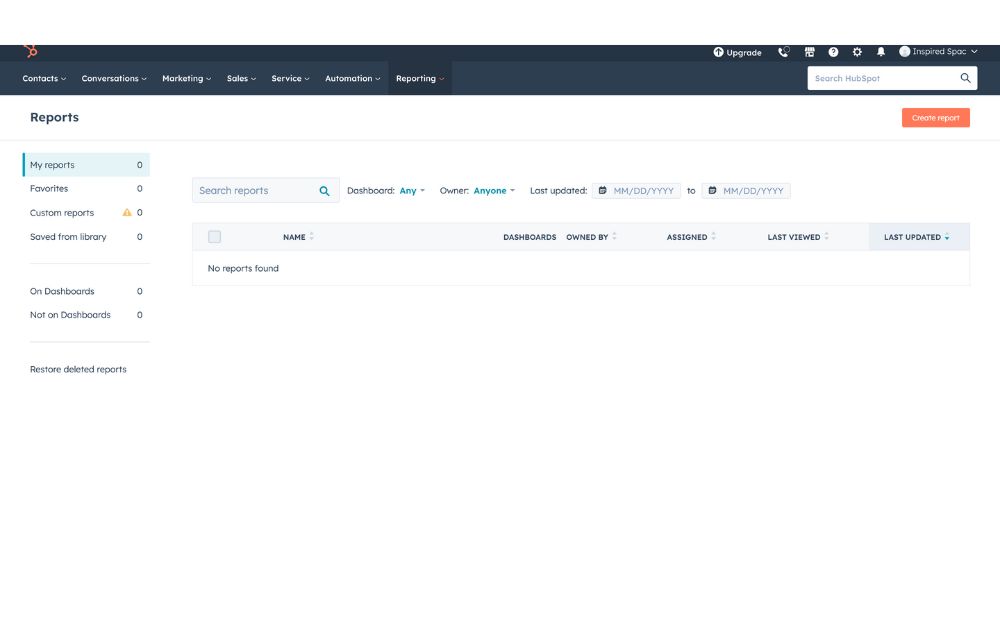
- Offer Self-Serve Options. Another way how to use HubSpot CRM is to empower customers to find solutions on their own, reducing the load on support teams and providing instant answers to common queries. Set up a knowledge base or FAQ section using HubSpot’s tools and populate it with articles, guides, and tutorials addressing common questions or issues. You can also Integrate chatbots that can guide customers to relevant self-serve resources based on their queries.
TIP: Regularly update the self-serve content based on emerging customer needs. Monitor which topics are most accessed to identify areas that might require more detailed resources or improvements.
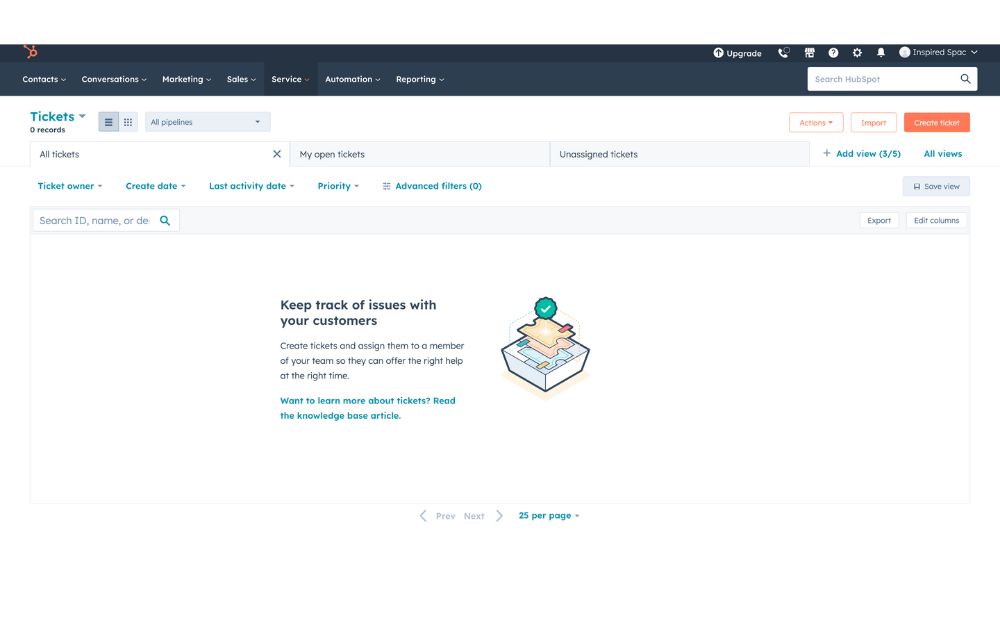
The platform offers a wealth of resources, offering info on how to use HubSpot CRM for beginners and advanced users alike.
HubSpot Success Tricks From Users
Here are ten tricks to make the most out of HubSpot CRM:
- Set Clear Objectives. Before diving into HubSpot, define what you want to achieve. Whether it’s lead generation, sales conversion, or customer service, having clear objectives will guide your CRM strategy.
- Customize Your Dashboard. Tailor your HubSpot dashboard to your needs. By customizing it, you can have quick access to the most relevant data and tools for your business.
- Use HubSpot’s Email Tracking. This feature allows you to see when a recipient opens your email. It’s a valuable tool for sales teams to gauge interest and follow up at the right time.
- Integrate with Other Tools. HubSpot CRM can be integrated with a plethora of other tools. Also, make sure to integrate them for a seamless workflow.
- Leverage the Power of Automation. Use automation tools to streamline tasks like lead nurturing, email campaigns, and more. This not only saves time but ensures consistency in your processes.
- Regularly Clean and Update Your Data. To ensure the efficiency of your CRM, regularly clean up and update your contact and company data. This helps in maintaining accurate records and improves targeting.
- Utilize HubSpot’s Reporting Features. Dive deep into the analytics provided by HubSpot. Understand your sales funnel, track conversions, and measure the effectiveness of your campaigns.
- Engage in Continuous Learning. HubSpot offers a range of tutorials, courses, and certifications. Engage in continuous learning to stay updated with the platform’s latest features and best practices.
- Segment Your Contacts. Group your contacts based on certain criteria like demographics, behavior, or purchase history. This allows for more personalized and effective communication.
- Optimize for Mobile. Ensure that your emails and landing pages are mobile-friendly. With a significant number of users accessing content on mobile devices, it’s crucial to provide an optimal experience for them.
Frequently Asked Questions (FAQs)
Here are a few frequently asked questions related to the platform:
What is CRM for beginners?
CRM, which stands for Customer Relationship Management, is a software system designed to manage and optimize a company’s interactions with its customers and prospects. For beginners, think of CRM as a digital address book on steroids. It not only stores contact information but also tracks customer interactions, sales history, preferences, and more. By centralizing this data, CRM tools help businesses understand their customers better. It also assists in streamlining communication and enhancing sales and marketing efforts.
What is HubSpot, and how can I use it?
HubSpot is an inbound marketing, sales, and customer service platform designed to help businesses attract and engage customers. With its suite of tools, including CRM, email marketing, landing page creation, and analytics, businesses can manage and optimize their customer interactions from one centralized dashboard. To use HubSpot, simply sign up for an account, customize it to fit your business needs, and leverage its features.
Is HubSpot CRM easy to use?
HubSpot CRM is designed with user-friendliness in mind, catering to both beginners and seasoned professionals. Its intuitive interface, drag-and-drop features, and onboarding tutorials make it easy for users to navigate and manage their customer relationships. Moreover, HubSpot offers a wealth of resources, including webinars, articles, and support forums, to assist users in maximizing the platform’s features.
What is HubSpot CRM best for?
HubSpot CRM is great for helping businesses keep track of their customers. It’s easy to use and has tools for marketing, sales, and service. With HubSpot, companies can easily manage leads, see customer details, and check how well they’re doing. It’s a one-stop shop for building strong customer relationships.
Mastering HubSpot CRM
HubSpot CRM emerges as an all-in-one tool to streamline and optimize your interactions with customers. From setting up your account to diving deep into analytics, each feature is tailored to ensure you’re not just using the platform but truly leveraging its full potential.
As you continue your journey with HubSpot CRM, remember that the key lies in continuous learning, adaptation, and staying updated with the platform’s evolving features.
If you’re looking to elevate your HubSpot CRM experience with impeccable graphics, designs, or marketing materials, check out Penji.
Our team of expert designers can craft visuals that resonate with your brand and enhance your HubSpot campaigns. Ready to transform your marketing visuals? Get started with Penji today and watch your HubSpot CRM campaigns shine brighter than ever!
About the author

Carla Deña
Carla is a journalist and content writer who produces stories for both digital and legacy media. She is passionate about creativity, innovation, and helping small businesses explore solutions that drive growth and social impact.
Table of Contents
- Step 1: Set Up Your Account
- Step 2: Manage Your CRM Database
- Step 3: Market Your Business
- Step 4: Generate Sales
- Step 5: Support Your Customers
- HubSpot Success Tricks From Users
- Frequently Asked Questions (FAQs)
- What is CRM for beginners?
- What is HubSpot, and how can I use it?
- Is HubSpot CRM easy to use?
- What is HubSpot CRM best for?
- Mastering HubSpot CRM










